BRESCIA
Buffer Zone
BRESCIA / THE BUFFER ZONE
The buffer zone of the area proposed for candidacy corresponds to the North-Eastern area of the city’s historical centre, and includes the whole area occupied by the city in Longobard times, which was included in the wall enceinte dating back to Roman times (end of the 1st century B.C. to the beginning of the 1st century A.D.) and the subsequent Early Medieval enlargement, which comprised an additional area situated west, and including the Longobard power centre known as the Curia Ducis, and eventually also the San Faustino Monastic complex, which was founded during the Carolingian period.
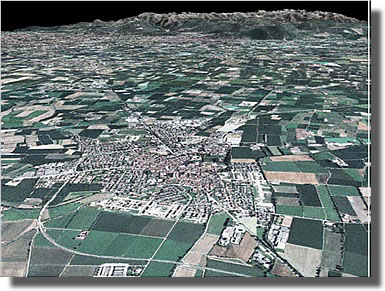
The Eastern Brescia plain
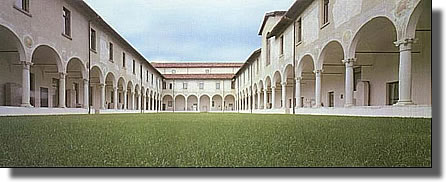
Monastic complex of San Giustino
To the North the limit proposed slightly exceeds the limits of the supposed route of the city walls of the Augustan period, and include the whole of the Cidneo Hill, a notable morphological element in the urban development and in the history of the city of Brescia.
A remarkable number of finds dating to the Longobard period, have been found all over this urban portion. They belong to residential and military buildings, productive structures, habitations and burials, some of which can be easily viewed, and can be visited, while others are not always accessible, and have been detected during archaeological emergency excavations (that is, unscheduled archaeological excavations carried out due to the casual discovery of ancient remains).
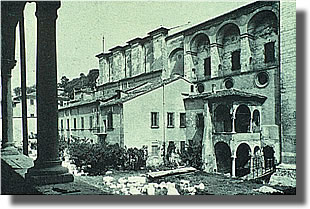
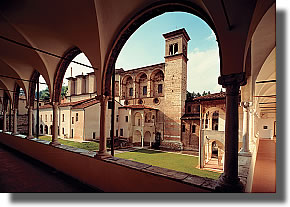
The Monastic complex of Santa Giulia before and afterwards the restauration
In some cases the remains are visible in situ as they are incorporated within buildings of the post-medieval period; in other cases they have been recuperated and exposed in the Longobard itinerary of the Museo della Città, housed in the Monastic complex of Santa Giulia.
Other structures have been left in situ, have been equipped with protective covering and re-buried.


Roman remains inside the Santa Giulia Monastic complex
- THE CURIA DUCIS AND THE CASTRUM
- HABITATIONS AND PRODUCTION STRUCTURES
- BURIALS
- PALAZZO MARTINENGO CESARESCO NOVARINO
- THE SQUARES
- SAN FAUSTINO MAGGIORE MONASTERY
- THE CIDNEO HILL
- THE MUSEUM NETWORK
THE CURIA DUCIS AND THE CASTRUM
The court of the Longobard Duke who ruled the city was placed at the western end of the main street axis, and alterations were made to the Late Antique Palatium. It is recorded in a 761 AD document, and its memory lives on in the place name Cordusio (from curia ducis).
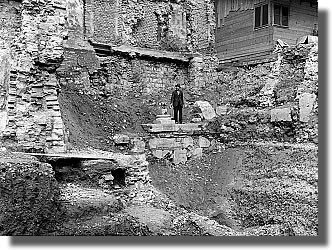
Archaeological excavations in Piazza Vittoria (1931-1932)
The building excavated in today’s Piazza Vittoria between 1931 and 1932 comprised a large Late Antique structure with subsidiary buildings which was equipped with a large colonnade during the Longobard period. Near this palace was a church dedicated to Saint Ambrose.
A fortified area on the summit of Cidneo Hill may have existed also during the Longobard period, in an area which lay to the north of the complex of San Salvatore-Santa Giulia, where bishops’ burials dating from the 7th century have been discovered within the two Churches of San Pietro and Santo Stefano.
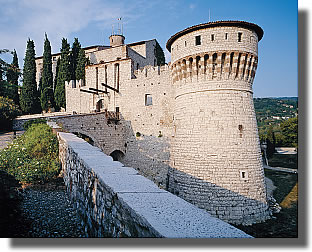
The Castle on the Cidneo hill
HABITATIONS AND PRODUCTION STRUCTURES
The monumental area and the Monastery rise along the axis constituted by via dei Musei, where Longobard buildings have been discovered, sometimes within roman buildings, which had originally been equipped with frescoes and mosaic floors, and whose walls still emerged from the debris. Longobard houses were erecting largely by re-using materials such as bricks and stones.
Single homes comprised of one or more rooms, with a beaten earth floor and wood partitions; often the main room was equipped with a fire hearth. Near these habitations rose facilities rose to produce metalwork, ceramics, and bone artefacts.
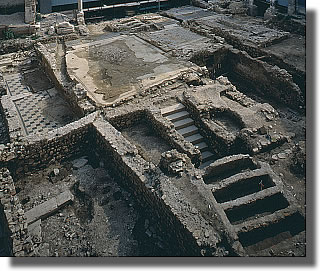 |
 |
| Roman buildings in Santa Giulia complex | Oven for pottery production discovered in the Capitolium area |
Archaeological excavations carried out in the city’s eastern areas enclosed by many so-called “dark layers” lying over the ruins of Roman houses, that is, dark coloured earth, which is the main indication of the presence of agricultural activity and of pastures in urban areas.
BURIALS
The burials identified in the city are mainly concentrated within the buffer zone, and are mostly concentrated in areas close to the main public buildings of the Roman city, or else in or close to the San Salvatore-Santa Giulia monastic complex.
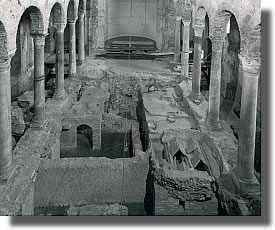 |
 |
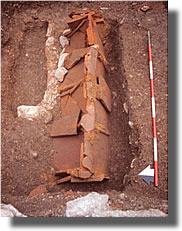 |
| Roman buildings in Santa Giulia complex during the archaeological surveys | Longobard burials |
The very simple tombs, sometimes comprising a stone slab coffin shaped structure, more often being depositions in the naked soil or showing a simple brick cover have been discovered by the tabernae or the Forum baths, or over the floors of the Imperial period houses. The presence of these burials also in neighbourhoods which do not possess the same strong characterization confirms the diffuse nature of the settlement.
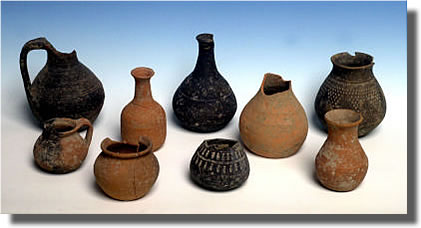
Craftsmanship of the Longobard era
Except for the ceramic artefacts relating to productive structures, the ceramic artefacts have been found in association with levels of use, habitations and burials, and were sometimes included in the funerary furnishings.
Apart from the Longobard period finds, the buffer zone also includes the majority, and the most significant part of the city buildings and urban spaces. As most italian cities, Brescia is a centre of where continuity has been key, so each historical period has made an imprint which is still visible.
PALAZZO MARTINENGO CESARESCO NOVARINO
The Palazzo Martinengo Cesaresco Novarino dates from the second half of the 17th, and is now the seat of many provincial administrative institutions rises over some remains of the Forum of the Roman Period and of the ancient structures which predate it (the most ancient of these date back to the Augustan period, i.e., from the 1st century BC to the 1st century AD).
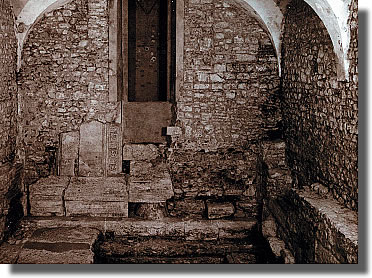

Archaeological excavations under Palazzo Martinengo
The archaeological excavations carried out between 1989 and 1997 in the building’s basement have brought to light materials datable between the 8th century B.C. up to the 16th 17th century A.D., that is to say, remains dating from the Iron Age (mostly remains of wood and clay habitations), to Roman times (an Augustan domus and Roman baths dating from the Flavian period), as well as monumental remains of the Forum and of buildings from the Early Medieval period. The majority of walls visible today date from this last period, as they were built between the 5th and the 7th century A.D., and testify the widespread re-use of architectural elements originally belonging to the Forum porticoes.
THE SQUARES
Ample squares were and still are the main meeting place for the city dwellers: a good example is the ancient piazza del Duomo, today renames Piazza Paolo VI, which includes the Romanesque church of the Duomo, a centrally planned building also known as the “Rotonda”), the 18th century Duomo Nuovo and the Medieval palazzo del Broletto, the seat of power during the Communal period.
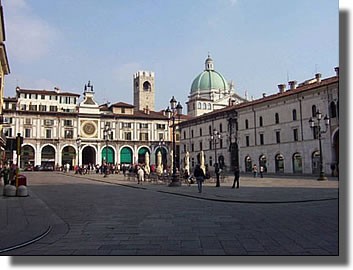
Piazza della Loggia
Another important square is Piazza della Loggia, created during the 15th century Venetian rule, dominated by Palazzo della Loggia (City Hall), today the seat of the Comune di Brescia. Since year 1480 the façades of the palaces known as “delle Carceri”, “del Monte Vecchio” and “del Monte Nuovo di Pietà” are graced by many Roman inscriptions, which constitute one of Italy’s oldest public collections of epigraphical inscriptions.
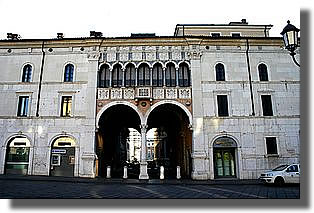 |
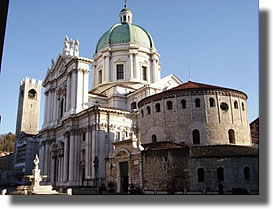 |
| Piazza della Loggia. Palazzo “del Monte Vecchio” | Piazza Paolo VI. The New and the Old Duomo |
The most recent of Brescia’s squares is Piazza della Vittoria, one of the most significant examples of fascist architecture and town planning, built during the 1930 by demolishing an old working class neighbourhood. Near the Monastery is Piazza Tebaldo Brusato, once known as Piazza del Mercato Nuovo, an ample public space, which occupies an area which once belonged to the Monastery itself.
SAN FAUSTINO MAGGIORE MONASTERY
The Benedictine Monastery, called San Faustino Maggiore was founded during Carolingian times and is now the seat of city university, Università degli Studi di Brescia.
Apart from this institution, many churches exemplify the city’s historical an artistic past, together with the many patrician palaces which ennoble the city’s skyline; both in the churches and in the palaces there are still today frescoes and works of art created by the most important Italian artists, such as Titian, Romanino and Moretto.
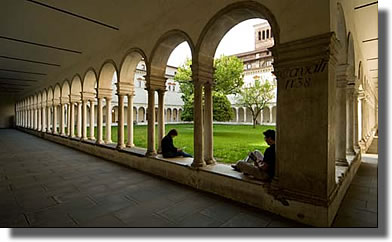
The Cloister of S. Faustino Maggiore
THE CIDNEO HILL
Finally, the city centre’s dominating characteristic is the Cidneo Hill, where a castle was built and developed over the centuries, and which is today enclosed within an urban park and an ancient vineyard; the latter is owned by the nuns of the Santa Giulia monastery and measures about 4 hectares, and sprawls over the lower reaches of the hill to the North, and constitutes Europe’s largest productive urban vineyard.
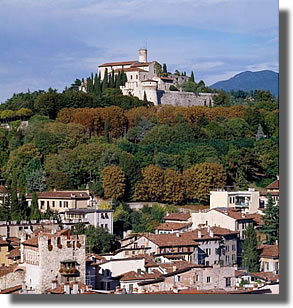
The Cidneo hill with the Castle
THE MUSEUM NETWORK
The city boasts an ample museum network. Apart from the complex called San Salvatore-Santa Giulia. Museo della città, it includes many city museums which are housed within historical buildings: the Museo Romano (in the Capitolium), the picture gallery called Pinacoteca Tosi Martinengo (in Palazzo Martinengo da Barco), the Museo del Risorgimento (in the Grande Miglio in the city’s castle), and the Museo delle Armi “Luigi Marzoli” (in the castle donjon), and the Natural History Museum or Museo di Storia Naturale.
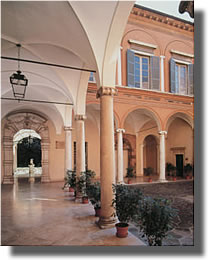
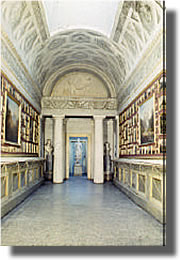
Requalification of the Palazzo Tosio Martinengo,
site of the Picture Gallery and Museum of the Nineteenth Century Collection
Moreover other Museums which are not property of the Comune di Brescia are also located in the city: the Museo Diocesano di Arte Sacra, the Museo Nazionale della Fotografia, the Collezione Arte e Spiritualità, the Museo delle Mille Miglia and a museum which is still being set up, called Museo dell’Industria e del Lavoro.


